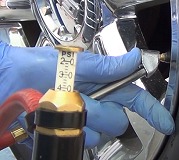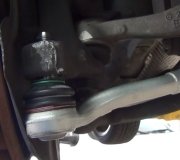The tire size you listed doesn't appear to be original tire size? My info listed 225 or 245/75r16,
40--65 psi.
INFORMATION
Bulletin No: 00-00-90-002K
Date: September 14, 2012
Subject: Information on Proper Tire Pressure
Models:
2013 and Prior GM Passenger Cars and Light Duty Trucks
Supercede:
This bulletin is being revised to add model years. Please discard Corporate Bulletin Number 00-00-90-002J (Section 00 - General Information).
Important
- Adjustment of tire pressure for a customer with a Low Tire Pressure Monitor (TPM) light on and no codes in the TPM system is NOT a warrantable repair. Claims to simply adjust the tire pressure will be rejected.
- ALL tires (including the spare tire) MUST be set to the recommended inflation pressure stated on the vehicle's tire placard (on driver's door) during the PRE-DELIVERY INSPECTION (PDI). Recommended inflation pressure is not the pressure printed on tire sidewall.
- Tires may be over-inflated from the assembly plant due to the mounting process.
- Generally a 5.6°C (10°F) temperature change will result in (is equivalent to) a 6.9 kPa (1 psi) tire pressure change.
- 2008-2009 HUMMER H2 Only - The H2 comes standard with Light Truck "D" Load Range tires with a recommended cold inflation pressure of 289 kPa (42 psi). These tires will alert the driver to a low pressure situation at roughly 262 kPa (38 psi) due to a requirement in FMVSS 138 which specifies a Minimum Activation Pressure for each tire type. This creates a relatively narrow window of "usable" pressure values and the warning will be more sensitive to outside temperature changes during the colder months.
As with other cold temperature/tire pressure issues, there is nothing wrong with the system itself. If a vehicle is brought in with this concern, check for tire damage and set all tires to the Recommended Cold Inflation Pressure shown on the vehicle placard.
Accurate tire pressures ensure the safe handling and appropriate ride characteristics of GM cars and trucks. It is critical that the tire pressure be adjusted to the specifications on the vehicle's tire placard during PDI.
Ride, handling and road noise concerns may be caused by improperly adjusted tire pressure.
The first step in the diagnosis of these concerns is to verify that the tires are inflated to the correct pressures. The recommended tire inflation pressure is listed on the vehicle's tire placard. The tire placard is located on the driver's side front or rear door edge, center pillar, or the rear compartment lid.
Tip
- Generally a 5.6°C (10°F) temperature increase will result in (is equivalent to) a 6.9 kPa (1 psi) tire pressure increase.
- The definition of a "cold" tire is one that has been sitting for at least 3 hours, or driven no more than 1.6 km (1 mi).
- On extremely cold days, if the vehicle has been outdoors, it may be necessary to compensate for the low external temperature by adding additional air to the tire during PDI.
- During cold weather, the Tire Pressure Monitor (TPM) indicator light (a yellow horseshoe with an exclamation point) may illuminate. If this indicator turns off after the tires warm up (reach operating temperature), the tire pressure should be reset to placard pressure at the cold temperature.
- The TPM system will work correctly with nitrogen in tires.
- The TPM system is compatible with the GM Vehicle Care Tire Sealant but may not be with other commercially available sealants.
Important
- Do not use the tire pressure indicated on the tire itself as a guide.
- Always inspect and adjust the pressure when the tires are cold.
- Vehicles that have different pressures for the front and the rear need to be adjusted after tire rotation.
Improper tire inflation may result in any or all of the following conditions:
- Premature tire wear
- Harsh ride
- Excessive road noise
- Poor handling
- Reduced fuel economy
- Low Tire Pressure Monitor (TPM) Light ON
- Low Tire Pressure Message on the Drivers Information Center (DIC)
Saturday, October 31st, 2020 AT 1:12 PM
(Merged)




